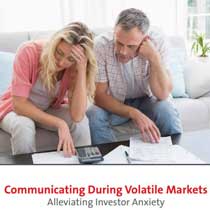Do you have a communication strategy?
When the markets experience turmoil, investors get nervous.
They often turn to their financial advisor for guidance and even reassurance. Is your firm prepared? It’s a good idea to have a communication plan at the ready that advisors can quickly turn to when needed.
When talking with investors and advisors, follow these 4 tips:
1. Stick to your messages
Keep your message clear, concise and consistent. Focus on the core principles of your strategy regardless of the current market environment
2. Offer alternatives
Emotions are running high during times of volatility. If an investor isn’t comfortable riding out the volatility, provide other options. Giving them a choice allows them ownership and a sense of control in in the situation.
3. Present opportunities
Active managers take advantage of turbulent times seeking quality selections at reasonable prices. Let advisors know your firm views this as an opportunity to pick up good stocks, while relying on a disciplined and repeatable process. Let them know despite market turbulence your firm will remain true to its philosophy.
4. Historical perspective
Remind investors that volatility happens-it’s happened before, and it will happen again. Focus on your strategy and specific companies rather than market chatter.
Be proactive
In times of volatility you can sit back and wait until your clients call, OR you can be proactive and reach out first. Hearing from you, particularly in times of volatility can be reassuring. Picking up the phone and dialing each client individually is not likely realistic but there are other things you can do.
There are a myriad of communication tools you can use to reach out:
- Offer to host conference calls for clients, advisory firms, or consultants. Make sure your clients get to hear from your portfolio managers. Following the call, the ideas can be repurposed for educational content for your advisors to use with clients.
- Use emails to maintain regular contact with shareholders and be viewed as a thought leader by sharing information on stock picks or your perspective on market trends.
- Webinars allow you to reach many clients and shareholders at the same time. Q&A sessions allow for interactive dialogue.
- Hosting a regular podcast provides a platform for you to share thoughts on the market while reaching out clients
- Producing white papers and commentaries show thought leadership. White papers, both short and long, can be used as education materials for your audience. Advisors can share them with clients and they can be used by your sales team as well.
- Our society wants to read less and watch more. Use video to meet their needs. Video can be a great vehicle for producing a portfolio manager Q&A. Use them to address timely topics and performance while providing a face a personality to the audience.
- Blogging and social media go hand in hand. Both can be time consuming but if done well, can help you maintain contact with clients and investors, engage new followers, and provide an opportunity to be seen as a thought leader
- Appearing in the news media lends credibility. Press appearances can be added to your website, blog and social media channels, and links to appearances can be emailed to clients.
Timing is everything
Of course you want to be seen as a thought leader, but in times of volatility that’s probably not the best angle. Advisors concerned with volatility are looking for empathy and understanding. They are looking for someone to validate their concerns, and while no manager can ever guarantee things will turn around, acknowledging their concerns and listening goes a long way.
Putting together a communication strategy and supporting content pieces isn’t easy. It involves a significant amount of time and effort but in the end it’s well worth it.
Creating portfolio manager Q&As on evergreen topics such as “what investment trends mean to our strategy”, or “our stock selection process” are helpful to keep on hand. They can be distributed randomly, during calm markets, to keep you in front of clients and to maintain that connection.
Evergreen pieces can also be kept on hand by advisors to use as educational materials when talking with clients.
In volatile times you’ve got a plan in place and content ready to share with advisors – there won’t be any scrambling. Instead, because you were proactive, you’ve got a clearly thought out plan and solid content pieces on hand.
Once you’ve created your library of materials, make the most of them and consider ways to repurpose them. A white paper can be posted to your website, shared via email, shared across social media platforms, hard copies distributed at conferences, in client meetings, etc. Putting the effort into the piece will pay off in the end.
If you’re regularly communicating with your audience and have positioned yourself as a thought leader, they will turn to you in times of volatility. Because you’ve now put together a well thought out communication strategy, your response won’t be reactively scrambling. Instead, you’ll have solid materials at the ready to assure them.
You’re likely going to be remembered most for your response in times of volatility. Investors get nervous and need to know they can rely on you to be a port in a storm.
Looking for more ideas on communicating during volatile times?
| See our peer roundtable report: Communicating During Volatile Markets- Alleviating Investory Anxiety |
Read our special report: Addressing Investors' Emotions |
 |
 |
